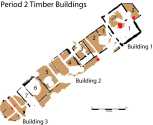
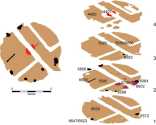
Left: All Early Roman Timber Buildings
Right: Early Roman Timber Building 3: the stratigraphy
Object 50010 | Plan (SVG) | Matrix 286 (SVG)


Left: All Early Roman Timber Buildings
Right: Early Roman Timber Building 3: the stratigraphy
A circular structure, Early Roman Timber Building 3 (ERTB3), was created immediately adjacent to the south-west end of ERTB2 by the excavation of a shallow (c. 200mm deep) cut (4408), lined with a thin layer of yellow clay (4419) and then filled with gravel (6628) to give a surface quite distinct from those of the internal spaces of ERTB1-2. It measured c. 7.45m in diameter. Excavation is incomplete and, as yet, there is no clear evidence, such as post-pits, to determine the character of the superstructure. Although it remains an assumption that a circular building actually stood above ground, it is difficult to imagine otherwise. It was clearly constructed in Phase 2 of Early Roman Timber Building 2 when Room 7 was dismantled and Room 6 was modified. There was evidence for a central hearth approximately 1.32m in diameter made up of tile fragments and burnt clay. From the south and south-east side came evidence of placed deposits in shallow pits cut close to, or on, the circumference of the structure.
Select a link to view various photographic images of Early Roman Timber Building 3

In all there is evidence for at least four successive surfaces of clay and gravel (5585, 6135, 6056, 4420/3927) with associated make-ups of coarse gravel. Set into cut 4408 and cutting through the earliest gravel make-up (6628) is a small pit (6572) measuring 0.55m in diameter with a depth of 0.2m. It contained a charcoal-rich fill with much burnt animal bone. A neonate human burial (6623) was also cut into this gravel make-up (The Infant Burial; FSF04054. These were sealed by a mix of gravel, clay and crushed ceramic building material forming a surface (5585). Covering this surface was another levelling deposit overlain by a burnt clay surface (6135). Into this were cut five small pits, four post-holes and a linear beam slot. Pit 6583 measured 0.6m in diameter, had a depth of 0.35m and was filled with a charcoal-rich clay and gravel deposit.
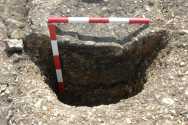
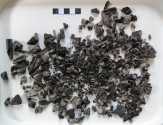
Left: Pit 6583
Right: Cremated remains of sheep/goat from shallow pit 6064
Pit 6064 was 0.5m in diameter with a depth of 0.2m. It was lined with small stones and contained charred and burnt deposits (see also the section Carbonised Plant Remains). It also contained the cremated remains of a sheep or goat. Small pit 6602 measured 0.24m in diameter, with a depth of 0.15m. It contained a placed pot (SF3729) within it (see also the section Pottery) and the cremated remains of a sheep/goat.
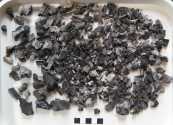
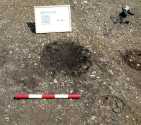
Left: Cremated remains of sheep/goat from pit 6602
Right: Pit 6064 with small pit 6602 in the foreground

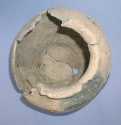
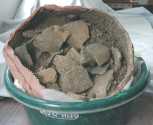
Showing (from left to right): Silchester Ware jar SF3729 from pit 6602
Context 6065 was a pit measuring 0.38m by 0.29m with a depth of 0.13m, and it contained a mix of charcoal and burnt animal (caprine) bone (see also the Animal Bone and Carbonised Plant Remains sections). Pit 6586 was 0.32m in diameter with an exceptionally shallow depth of 0.09m. It contained the remains of a placed pot SF3967 within it, crushed in situ.
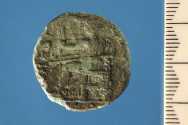

Left: Reverse view of coin of ?Claudius SF3985
Right: Obverse view of coin of ?Claudius SF3985
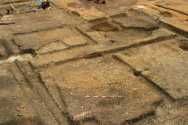

Showing (from left to right): Clay surface 5556; views from the west
Overlying this floor was another make-up 3925 which produced a Claudian copy (SF3777), probably dating to the 50s and the reign of Nero.
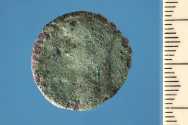
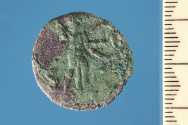
Left: Obverse view of Claudian copy coin SF3777
Right: Reverse view of Claudian copy coin SF3777
Cut into this make-up was another small pit (6582), c. 0.35m in diameter and 0.12m deep, containing another charcoal-rich fill. This in turn was sealed by the final clay surface 4420/3927 into which was set the hearth 4407.
Although reminiscent in plan, and in the location of significant features on the south side, of an Iron Age round-house, given the lack of evidence for post-holes, etc., it is too early to be conclusive about our interpretation of the circular structure and whether it represented the remains of a circular, residential building. Its proximity to ERTB2 suggests it forms part of the same property. Indeed the eaves of the two buildings would have clashed if Room 7 had remained standing.
One explanation for the apparent fragility of the structure is that it was contained within a further structure. In the 2006 season it appears that a row of stone post pads (reusing similar Bath stone architectural fragments as Room 6 in ERTB2 (phase 2)), which lies to the south of ERTB3, is contemporary with it. It is difficult to understand the function of this feature unless it supported a verandah or portico fronting the circular structure. As an isolated feature it makes little sense but it could be construed as the south-facing elevation of a rectangular timber building, the evidence for which was destroyed by the succeeding, Period 3, masonry house. In this respect it is worth noting that the two vessels, one a Silchester ware jar (FSF02039), the other an Alice Holt bead-rim jar (FSF02549), believed to have been placed as foundation deposits in two corners of the Period 3 house, would have been relatively old at the time of their deposition in the second quarter of the 2nd century. Perhaps they are to be associated with a rectangular timber building enclosing ERTB3?

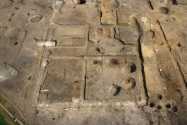

Left: Line of postpads, view from west
Middle: Timber building 3 with the line of postpads shown on the right-hand side, view from west
Right: Line of postpads, from west
There are both presences and absence among the finds which deserve comment. We have already noted the human neonate (28-34 weeks) burial and the pits with evidence of cremated caprines, very probably sacrifices, one of which also contained the remains of a Silchester Ware jar. Also among the animal bone Claire Ingrem notes the the pelvis of a foetal or neonate piglet. Of the material finds, Nina Crummy argues that two brooches were ritual deposits associated with the foundation of the building, while in the very small assemblage of glass, there are the remains of a probable unguent bottle. Like the glass, the pottery was represented by a small assemblage, dominated by Silchester Ware and with a small proportion of continental imports (5.3%).
Two coins provide a terminus post quem of the 50s, while the pottery points to an early Flavian date.
© Internet Archaeology
URL: http://intarch.ac.uk/journal/issue21/4/p2_ertb3.htm
Last updated: Wed Sept 12 2007